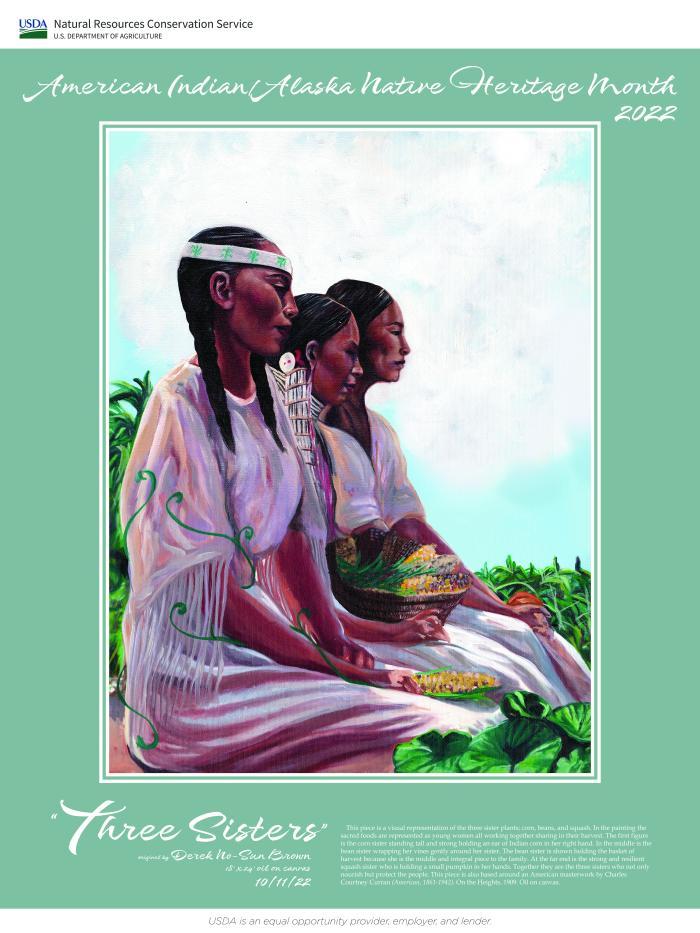
NRCS field office personnel provides assistance upon request to private landowners and operators, Indian tribes and Tribal members.
NRCS has expertise in agronomy, range management, forestry, agricultural engineering, soils, water management, wildlife habitat management, aquaculture, resource inventories, and watershed and flood protection.
NRCS field office personnel provides assistance upon request to private landowners and operators, Indian tribes and Tribal members. Assistance provided includes, but is not limited to, the following: Conservation planning on cropland, pastureland, and rangeland and assistance to apply rangeland management and improvement practices, irrigation water development structures and management, brush control, erosion control structures, agriculture, forestry, farmland protection, wildlife habitat improvement, and wetlands restoration.
American Indians and Alaska Natives are eligible to participate in all NRCS programs and may have special status as provided by statute or regulation. The demand for NRCS services by American Indian tribal groups continues to increase as the value of NRCS assistance becomes better understood.
NRCS Programs for Tribes and Tribal Members
The NRCS provides technical assistance and financial assistance to private landowners and operators, tribes and tribal members to assist them in protecting and improving natural resources such as soil, water, air, plants, and animals.
NRCS can assist tribes and tribal members in conservation work, and how to apply for NRCS programs such as the Environmental Quality Incentives Program (EQIP) which has fund pools designed specifically for tribal Conservation goals with acknowledgement of tribal traditional lands management.
In California, we have worked with tribes in more conventional agricultural landscapes such as orchards, and row crops, but we have also sought to acknowledge the unique relationships that California’s first peoples have with the land, traditional methods of land stewardship and agriculture and traditional ecological knowledge that have been passed on for generations. With that in mind and in coordination with our Tribal Advisory Committee, we have developed and continued to refine fund pools designed specifically for tribal Conservation goals. Tribal Traditional Plant Restoration, Tribal Diversified Farms, Tribal Forestland, and Tribal Rangeland EQIP fund pools focus specifically on Indigenous lands management and agricultural production.
California Tribal Advisory Committee
Initiated in 2015, the California Tribal Advisory Committee (TAC) is a forum for the Native American Tribes and tribal members in California to address natural resource issues on tribal lands. The TAC provides tribes an opportunity to voice conservation issues that are important to them directly to the State Conservationist and in doing so, help to shape the NRCS California Tribal Program. At our biannual meetings, the TAC receives updates on USDA and NRCS specific policy and programs, and can provide feedback that will be taken into account for the purpose of tribal programs management including ranking criteria, practice and practice scenario application, as well as broadening the NRCS planning process to better assist tribes.
American Indian/Alaska Native Heritage Month Posters
American Indian Heritage Month is observed from November 1 through November 30. American Indian Heritage Month is celebrated to recognize the intertribal cultures and to educate the public about the heritage, history, art, and traditions of American Indians and Alaska Natives. American Indian Heritage Month enhances our efforts to honor tribal sovereignty by working on a Government-to-Government basis with American Indians and Alaska Natives. We honor the rights of Indian tribes and work to protect and enhance tribal resources. The Natural Resources Conservation Service (NRCS) creates a poster every year to from the artwork of an American Indian artist to celebrate American Indian and Alaska Native Heritage Month in November.
Tribal Conservation Advisory Committees were first authorized in the 1996 Farm Bill as advisory bodies to USDA agencies including NRCS on Tribal issues.

This year’s artwork theme is “The Three Sisters of Indigenous American Agriculture.”
“This piece is a visual representation of the three sister plants corn, beans, and squash. In the painting, the sacred foods are represented as young women all working together sharing in their harvest. The first figure is the corn sister standing tall and strong holding an ear of Indian corn in her right hand. In the middle is the bean sister wrapping her vines gently around her sister. The bean sister is shown holding the basket of harvest because she is the middle and integral piece to the family. At the far end is the strong and resilient squash sister, who is holding a small pumpkin in her hands. Together they are the three sisters who not only nourish but protect the people,” said No-Sun when describing “Three Sisters.”
Derek No-Sun Brown is an entrepreneur and artist who is blessed to be carrying on ancestry from the Shoshone Bannock, Klamath and Anishinabe people. Born in 1986, He was raised with a strong traditional foundation and continues to maintain indigenous ways of prayer and philosophy that is evident through his art. No-Sun grew up on the Fort Hall Indian Reservation in Idaho and the Boise Forte Reservation in northern Minnesota. Traveling back and forth to his maternal and paternal homelands is how the young artist began to expand his mind and see things from an alternative perspective.
No-Sun attended Idaho State University but received his Bachelor of Fine Arts in 2013 from the Institute of American Indian Arts in Santa Fe, New Mexico. No-Sun has also combined his love for art, painting, sculpture, apparel and entrepreneurship into a business called War Medicine that has been going strong since the official opening date in May 2013. His talent expanded into the public art world as of 2021 with the completion of two large scale building murals in Portland, and the last one in Gladstone Oregon. Recently, a stainless-steel sculpture series called “Water-Fall Salmon & Woven Dreams” was installed in Keizer, Oregon, in September 2022.
The sponsors of this year’s poster contest are NRCS Idaho, NRCS Oklahoma and NRCS Washington.
For more information about American Indian and Alaska Native Heritage Month, please visit the Native American Heritage Month website.
NRCS Plant Material Centers
Natural resources on tribal lands may be culturally and historically sensitive. The NRCS Plant Materials Program (PMP) provides technical assistance to federally-recognized tribes in these areas. Assistance to tribes from the Plant Materials Centers (PMC) may include: 1) collecting seed and/or plants of concern, 2) determining propagation protocols, 3) selecting for desirable attributes, and 3) developing plant establishment and maintenance guidelines.
There are four plant materials centers serving the many bioregions of California:
- California - Lockeford Plant Materials Center, Lockeford, CA
- Arizona - Tucson Plant Materials Center, Tucson, AZ
- Nevada - Great Basin Plant Materials Center, Fallon, NV
- Oregon - Corvallis Plant Materials Center, Corvallis, OR
Related Information
Additional Information
The California Tribal Advisory Committee (TAC) is a forum for the Native American Tribes and tribal members in California to address natural resource issues on tribal lands.
California Tribal Advisory Committee
Initiated in 2015, the California Tribal Advisory Committee (TAC) is a forum for the Native American Tribes and tribal members in California to address natural resource issues on tribal lands.
Learn More
